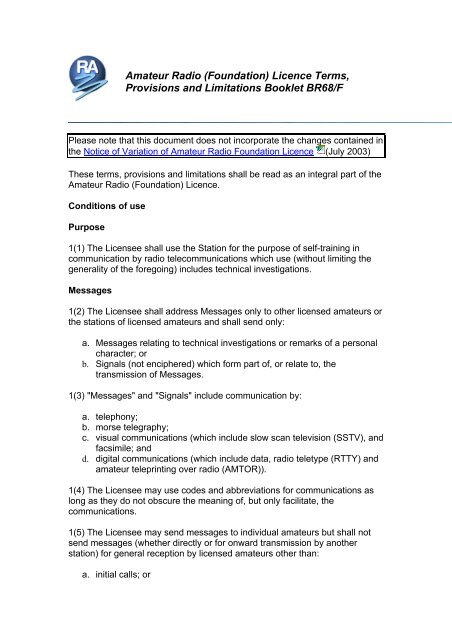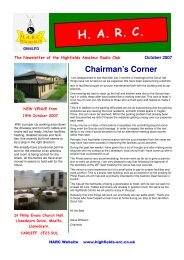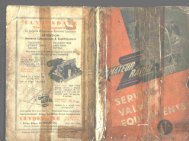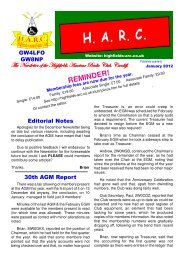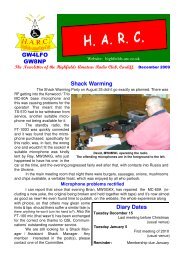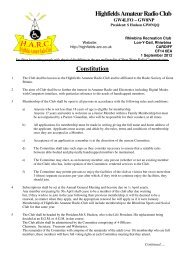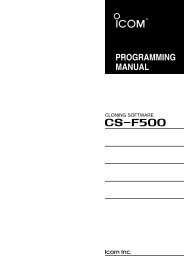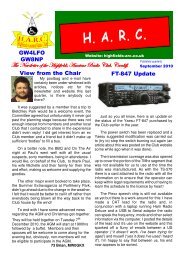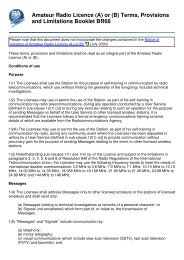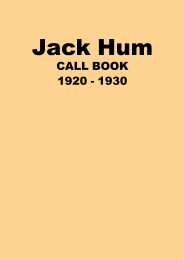BR68/F - Highfields Amateur Radio Club
BR68/F - Highfields Amateur Radio Club
BR68/F - Highfields Amateur Radio Club
Create successful ePaper yourself
Turn your PDF publications into a flip-book with our unique Google optimized e-Paper software.
<strong>Amateur</strong> <strong>Radio</strong> (Foundation) Licence Terms,<br />
Provisions and Limitations Booklet <strong>BR68</strong>/F<br />
Please note that this document does not incorporate the changes contained in<br />
the Notice of Variation of <strong>Amateur</strong> <strong>Radio</strong> Foundation Licence (July 2003)<br />
These terms, provisions and limitations shall be read as an integral part of the<br />
<strong>Amateur</strong> <strong>Radio</strong> (Foundation) Licence.<br />
Conditions of use<br />
Purpose<br />
1(1) The Licensee shall use the Station for the purpose of self-training in<br />
communication by radio telecommunications which use (without limiting the<br />
generality of the foregoing) includes technical investigations.<br />
Messages<br />
1(2) The Licensee shall address Messages only to other licensed amateurs or<br />
the stations of licensed amateurs and shall send only:<br />
a. Messages relating to technical investigations or remarks of a personal<br />
character; or<br />
b. Signals (not enciphered) which form part of, or relate to, the<br />
transmission of Messages.<br />
1(3) "Messages" and "Signals" include communication by:<br />
a. telephony;<br />
b. morse telegraphy;<br />
c. visual communications (which include slow scan television (SSTV), and<br />
facsimile; and<br />
d. digital communications (which include data, radio teletype (RTTY) and<br />
amateur teleprinting over radio (AMTOR)).<br />
1(4) The Licensee may use codes and abbreviations for communications as<br />
long as they do not obscure the meaning of, but only facilitate, the<br />
communications.<br />
1(5) The Licensee may send messages to individual amateurs but shall not<br />
send messages (whether directly or for onward transmission by another<br />
station) for general reception by licensed amateurs other than:<br />
a. initial calls; or
. to groups of licensed amateurs as long as communication is first<br />
established separately with at least one licensed amateur in any such<br />
group; or<br />
c. to licensed amateurs who participate within a net and subject to the<br />
identification requirements provided for in sub-clause 7(1A) below; or<br />
d. messages transmitted via a mailbox or bulletin board for reception by<br />
all or any licensed amateurs who have the facility to transmit and<br />
receive RTTY or data transmissions.<br />
1(6) The Licensee shall not transmit such material as music, public<br />
broadcasts or speeches.<br />
Location<br />
1(7) "Station" means the station of the Licensee at the Main Station Address,<br />
a Temporary Location or while Mobile, as the case may be.<br />
1(8) The Licensee shall operate the Station only:<br />
a. at the Main Station Address ("Main Station Address" means the main<br />
station address of the Licensee set forth in the Validation Document);<br />
b. at a Temporary Location ("Temporary Location" means a location,<br />
other than the Main Station Address, in the United Kingdom, and in any<br />
fixed position);<br />
c. While Mobile ("Mobile" means located in the United Kingdom in any<br />
vehicle, as a pedestrian or on any Vessel in Inland Waters).<br />
1(9) The Licensee shall give prior written notice to the Secretary of State at<br />
the address specified in note (a) to this Booklet of any change in the Main<br />
Station Address (or mailing address, if different).<br />
Standard Frequency Service<br />
1(10) The Licensee may use the Station for the reception of transmissions in<br />
the Standard Frequency Service (a radio communication service for scientific,<br />
technical and other purposes, providing the transmission of specific<br />
frequencies of stated high precision, intended for general reception).<br />
Top<br />
Limitations on use<br />
2(1) The Licensee shall only use:<br />
a. the frequency bands specified in the first column of the Schedule to this<br />
Licence subject to the limitations set out in the second column of the<br />
Schedule;
. a power not exceeding the maximum specified in the third column of<br />
the Schedule; and<br />
c. the types of transmission specified in the fourth column of the<br />
Schedule.<br />
2(2) The Licensee may receive Messages from an overseas amateur or from<br />
a UK amateur duly authorised by the Secretary of State on a frequency band<br />
not specified in the first column of the Schedule as long as the Licensee<br />
transmits only in a band specified in the first column of the Schedule which is<br />
authorised under sub-clause 2(1).<br />
Pulse emissions<br />
2(3) The Licensee shall not use pulse emissions.<br />
Operators<br />
2(4) The Station shall be operated only by the Licensee personally.<br />
2(5) The Licensee may permit any person to type the Message of the<br />
Licensee for transmission by the Licensee from the Station.<br />
Aircraft and vessels<br />
2(6) The Licensee shall not establish or use the Station on any vessel, other<br />
than in Inland Waters, or in any aircraft or other airborne vehicle.<br />
Other requirements<br />
3(1) The Licensee shall hold a Foundation Licence Training Course<br />
Completion Slip.<br />
3(2) The Licensee shall comply with:<br />
a. the relevant provisions of the Telecommunication Convention and<br />
<strong>Radio</strong> Regulations unless such compliance would result in a breach of<br />
the Licence; and<br />
b. all relevant statutory enactments including (without limiting the<br />
generality of the foregoing) the Act, the Wireless Telegraphy Act 1967<br />
and the Telecommunications Act 1984.<br />
3(3) The Licensee shall:<br />
a. have no pecuniary interest (direct or indirect) in any operations<br />
conducted under this Licence; and<br />
b. except in the case of activities on behalf of a non-profit organisation<br />
established for the furtherance of amateur radio, not use the Station for<br />
business, advertisement or propaganda purposes including (without<br />
limiting the generality of the foregoing) the sending of news or
Apparatus<br />
messages of, or on behalf of, or for the benefit or information of, any<br />
social, political, religious or commercial organisation.<br />
4(1) The Licensee shall only use transmitting equipment conforming to EC<br />
standards or commercially available kits transmitting inside amateur bands<br />
only.<br />
4(2) Notwithstanding any other term of this Licence, the Licensee shall ensure<br />
that the apparatus comprised in the Station is constructed, maintained and<br />
used, so that its use does not cause any undue interference to any wireless<br />
telegraphy.<br />
4(3) If any undue interference to wireless telegraphy is caused by the<br />
radiation of Unwanted Emissions or the field strength of electromagnetic<br />
energy radiated from the Station, then the Licensee shall suppress the<br />
Unwanted Emissions or reduce the level of the field strength to the level<br />
specified by the Secretary of State.<br />
4(4) The Station shall be capable of receiving Messages on the same<br />
frequencies and with the same classes of emission in use for the transmission<br />
of Messages by the Station.<br />
Recorded or retransmitted Messages<br />
5(1) The Licensee may record and retransmit Messages addressed to the<br />
Licensee from other licensed amateurs:<br />
a. with whom the Licensee is in direct communication; or<br />
b. which are intended for retransmission to a specified licensed amateur.<br />
5(2) The Licensee may send Messages by (or as part of) the intermediate<br />
relaying of the Messages to or from other licensed amateurs.<br />
5(3) When recording and retransmitting the Message of another licensed<br />
amateur, if the Licensee also records and retransmits the call sign of the<br />
licensed amateur, then the Licensee shall transmit the call sign in such a way<br />
that the origin of the Message and the origin of the retransmission are clear.<br />
5(4) Notwithstanding sub-clauses 5(1) and (2), the Licensee shall not operate<br />
the station as:<br />
a. a mailbox or bulletin board (each being a device which stores, in a<br />
readable form, complete messages which are not to or from the<br />
Licensee,for re-transmission on behalf of other licensed amateurs); or<br />
b. a telephony repeater (a facility which receives and simultaneously<br />
retransmits Messages by telephony for or on behalf of other licensed<br />
amateurs).
Log<br />
6(1) The Licensee shall keep a permanent record (the "Log") of all wireless<br />
telegraphy transmissions at the Main Station Address and all Temporary<br />
Locations showing:<br />
a. dates of transmission;<br />
b. the times (in Co-ordinated Universal Time (UTC)) during each day of<br />
i. the first and last transmissions from the Station; and<br />
ii. changes made to the frequency band, class of emission or<br />
power;<br />
c. frequency band of transmission;<br />
d. mode of transmission;<br />
e. power;<br />
f. initial calls ("CQ" calls) (whether or not they are answered);<br />
g. the call sign of licensed amateurs or licensed stations with which<br />
communications have been established (not including those amateurs<br />
or stations which form part of the intermediate relay of Messages); and<br />
h. location when the station is operated at a Temporary Location.<br />
6(2) The Log shall be written in a book or maintained on a magnetic tape, disc<br />
or other electronic storage medium. If the Log is maintained on an electronic<br />
storage medium the means to view the Log and produce a hard copy shall be<br />
kept readily available at the Main Station Address.<br />
6(3) Where the Log is maintained:<br />
a. in a book, the book shall not be loose-leaf and no gaps shall be left<br />
between the entries;<br />
b. on a magnetic tape, disc or other electronic storage medium,<br />
suitableprecautions should be taken to ensure that the log is backed<br />
up.<br />
6(4) The Licensee shall keep the log for inspection by a person authorised by<br />
the Secretary of State for a least six months from the date of the last entry<br />
whether or not this Licence has expired or been revoked.<br />
6(5) When a person authorised by the Secretary of State requires additional<br />
matters to be recorded, the Licensee shall record those additional matters in<br />
the Log for the period specified by that person.<br />
Top<br />
Identification
7(1) Subject to sub-clause (1A) below, which does not apply to operation via<br />
repeaters during transmissions, the Licensee shall transmit the call sign<br />
specified in the Validation Document:<br />
a. during initial calls ("CQ" calls);<br />
b. at the beginning and at the end of each period of communication with a<br />
licensed amateur and when the period of communication is longer than<br />
15 minutes, at the end of each interval of 15 minutes;<br />
c. at the beginning of transmission on a new frequency (whenever the<br />
frequency of transmission is changed);<br />
d. by the same type of transmission that is being used for the<br />
communication;<br />
e. on the same carrier frequency that is being used for the<br />
communication; and<br />
f. by morse telegraphy or telephony, at the end of each 30 minute period<br />
during which transmissions are sent from the Station (unless already<br />
transmitting in morse telegraphy or telephony).<br />
7(1A) When operating within a net, under sub-clause 1(5)(c), the Licensee<br />
shall observe the following requirements in relation to the transmission of his<br />
call sign:<br />
a. he shall transmit his call sign when he first joins the net and on leaving<br />
it;<br />
b. subject to sub-clause 7(1A) (c) below, whilst participating in the net, he<br />
shall not be obliged to transmit his call sign when making contact with<br />
other participants;<br />
c. whilst participating in the net, he shall transmit his call sign:<br />
i. when 15 minutes have elapsed since the last transmission of his<br />
call sign; or<br />
ii. if he has not transmitted speech before 15 minutes have<br />
elapsed since such transmission, on the first occasion thereafter<br />
on which he transmits speech.<br />
7(2) At a Temporary Location, the Licensee shall:<br />
a. use the suffix "/P" with his call sign and give the location of the Station<br />
every 30 minutes to an accuracy of at least 5km by a generally used<br />
identifier (for guidance see note (t) to this booklet); or<br />
b. give prior written notice of the location to the Operations Manager of<br />
the local office of the <strong>Radio</strong>communications Agency in whose area the<br />
operation is to take place.<br />
7(3) When Mobile, the Licensee shall use the suffix"/M".<br />
7(4) When away from the Main Station Address, the Licensee shall use the<br />
appropriate Regional Secondary Locator specified in note (w) to this Booklet.
7(5) The Secretary of State reserves the right to release details of the call sign<br />
of the Licensee specified in the Validation Document to third parties so that<br />
the call sign may be published in call books compiled by third parties, either in<br />
written form or in the form of "read only" computer disks.<br />
Inspection and close down<br />
8(1) The Licensee shall permit a person authorised by the Secretary of State:<br />
a. to have access to the Station; and<br />
b. to inspect the Licence and Log and to inspect the apparatus of the<br />
Station at any and all reasonable times (or when, in the opinion of the<br />
Secretary of State, an urgent situation exists at any time) for the<br />
purpose of verifying compliance with the terms of the Licence.<br />
8(2) When, in the opinion of a person authorised by the Secretary of State:<br />
a. the Licensee is in breach of the Licence; and<br />
b. breach justifies immediate restriction or close down, the Licensee shall<br />
restrict the operation of or close down and cease to operate, the station<br />
(or any apparatus comprised in the Station) forthwith in accordance<br />
with the demand of a person authorised by the Secretary of State for<br />
the temporary period specified in the demand.<br />
8(3) For the purposes of sub-section 1(4) of the Act, this Licence may be<br />
revoked, or its terms, provisions or limitations varied, by a notice in writing of<br />
the Secretary of State served on the Licensee, or by a general notice<br />
addressed to all holders of an <strong>Amateur</strong> <strong>Radio</strong> Foundation Licence published<br />
in the London, Edinburgh and Belfast Gazettes or broadcast nationally by the<br />
British Broadcasting Corporation.<br />
Period of Licence and fees due<br />
9(1) Subject to the payment, if appropriate, (for guidance see note (w) to this<br />
booklet) of the fee in the manner indicated in sub-clause 9(2), this Licence<br />
shall continue in force from year to year unless revoked by the Secretary of<br />
State.<br />
9(2) The Licensee shall pay to the Secretary of State before the anniversary<br />
date of the Date of Issue in each year, the fee on renewal prescribed by the<br />
Regulations for the time being in force under sub-section 2(1) of the Act, and<br />
on the payment of the fee the Secretary of State will issue to the Licensee a<br />
document in the form of the title page of this Licence (the "Validation<br />
Document") which will indicate the next date for renewal.<br />
9(3) If the Licensee does not pay any fee due and in the manner described in<br />
sub clause9(2), then the Licence shall expire at the end of the day before the<br />
relevant anniversary date of the Date of Issue.
9(4) The licensee shall surrender the Validation Document to the Secretary of<br />
State forthwith upon the revocation of the Licence. The Secretary of State<br />
reserves the right to publish the name and call sign of the Licensee if the<br />
Licence is revoked.<br />
Interpretation<br />
10(1) In this Licence, unless the context otherwise requires:<br />
a. The Interpretation Act 1978 shall apply to this Licence as it applies to<br />
an Act of Parliament;<br />
b. the expression "Co-ordinated Universal Time" has the same meaning<br />
as it has in the <strong>Radio</strong> Regulations (for guidance see note (s) to this<br />
booklet);<br />
c. "Act" means the Wireless Telegraphy Act 1949;<br />
d. "Inland Waters" means any canal, river, lake, loch or navigation which<br />
is not Tidal Water;<br />
e. "Inspect" means examine and test;<br />
f. "Licensee" means the licensee named in the Validation Document;<br />
g. "Secretary of State" means the Secretary of State for Trade and<br />
Industry;<br />
h. "Telecommunication Convention" and "<strong>Radio</strong> Regulations" mean the<br />
International Telecommunication Convention and the <strong>Radio</strong><br />
Regulations thereunder and include any Convention or Regulation<br />
which may from time to time be enacted or brought into force in<br />
substitution for, in amendment of, or in addition to, the<br />
Telecommunication Convention or <strong>Radio</strong> Regulations;<br />
i. "United Kingdom" means the United Kingdom of Great Britain and<br />
Northern Ireland, the Channel Islands and the Isle of Man;<br />
j. "Unwanted Emissions" means spurious emissions and out-of-band<br />
emissions as defined in the <strong>Radio</strong> Regulations;<br />
k. "Vessel" includes a hovercraft and any other floating structure which is<br />
capable of being manned;<br />
l. "Authorised Officer" means an authorised officer of the<br />
<strong>Radio</strong>communications Agency.<br />
10(2) The headings in this Licence are for ease of reference only and shall not<br />
affect the interpretation of the Licence.<br />
10(3) The Licence consists of the Validation Document, the Terms, Provisions<br />
and Limitations Booklet <strong>BR68</strong>/F and the Schedule to the Booklet as any of<br />
them may be varied from time to time.<br />
10(4) To the extent that they do not conflict with or are not inconsistent with<br />
any of the clauses herein, the Notes to the Schedule to the Booklet and the<br />
Notes to the Booklet shall be complied with by the Licensee.<br />
1 2 3 4<br />
Frequency Status of Allocations in Power Mode of
Bands in<br />
MHz<br />
the United Kingdom to the<br />
<strong>Amateur</strong> Service<br />
Transmission<br />
0.1357-<br />
0.1378<br />
1.810-<br />
1.830<br />
Secondary. Available on the<br />
basis of<br />
non-interference to other<br />
services (inside or outside<br />
the United Kingdom).<br />
Primary. Available on the<br />
basis of non-interference to<br />
other services (outside the<br />
United Kingdom)<br />
1W (0dBW) erp<br />
Power fed to the Antenna<br />
10 W (10dBW)<br />
Morse<br />
Telephony<br />
RTTY<br />
Data<br />
Facsimile<br />
SSTV<br />
1.830-<br />
1.850<br />
Primary<br />
1.850-<br />
2.000<br />
Available on the basis of<br />
non-interference to other<br />
services<br />
(inside or outside the United<br />
Kingdom)<br />
3.500-<br />
3.800<br />
Primary. Shared with other<br />
services<br />
7.000-<br />
7.100<br />
Primary<br />
10.100-<br />
10.150<br />
Secondary<br />
14.000-<br />
14.250<br />
14.250-<br />
14.350<br />
18.068-<br />
18.168<br />
Primary<br />
21.000-<br />
21.450<br />
24.890-<br />
24.990<br />
50.00-<br />
51.00<br />
Primary. Available on the<br />
basis of<br />
non-interference to other<br />
services<br />
(outside the United<br />
Kingdom)<br />
51.00-<br />
52.00<br />
70.00-<br />
Secondary. Available on the<br />
basis of<br />
non-interference to other
70.50 services<br />
(inside or outside the United<br />
Kingdom)<br />
144.0-<br />
146.0<br />
430.0-<br />
431.0<br />
431.0-<br />
432.0<br />
432.0-<br />
438.0<br />
438.0-<br />
440.0<br />
Primary<br />
Secondary<br />
Seondary. Not available for<br />
use<br />
within a 1000km radius of<br />
Charing Cross,<br />
London (51° 30' 30" N, 00°<br />
07' 24" W)<br />
Secondary<br />
Secondary<br />
10W (10dBW) erp<br />
10W (10dBW)<br />
Top<br />
Notes to the Schedule<br />
a. In all frequency bands, high intensities of RF radiation may be harmful<br />
and safety precautions should be taken, particularly in locations to<br />
which people have access. Advice concerning safe levels of exposure<br />
to RF radiation is provided by the National <strong>Radio</strong>logical Protection<br />
Board.<br />
b. Primary, permitted and secondary services<br />
For the purpose of this Licence, frequency bands allocated to the<br />
<strong>Amateur</strong> Service on a primary basis cannot claim protection from<br />
undue interference from any other authorised services, such protection<br />
being afforded only to users whose frequencies have been registered<br />
nationally or internationally. In the United Kingdom, individual<br />
frequency assignments are not registered in the <strong>Amateur</strong> Service,<br />
except for beacons and repeaters. This applies equally to all bands<br />
allocated on a secondary basis where stations of the <strong>Amateur</strong> Service<br />
are also required not to cause undue interference to stations of a<br />
primary or permitted service to which frequencies are already assigned<br />
or to which frequencies may be assigned at a later date.<br />
c. Any modulation technique (except for pulse emissions) may be used<br />
for the types of transmission specified in the fourth column of the<br />
Schedule which are defined as follows:<br />
Morse:<br />
hand or automatically-sent international morse code
Telephony:<br />
RTTY:<br />
Data:<br />
Facsimile:<br />
SSTV:<br />
speech, including selective calling signals using<br />
AM/FM or SSB modulation<br />
radio teletype and AMTOR<br />
digital codes representing numbers, text, speech,<br />
images, measurements, computer programmes or<br />
other information authorised by the Licence<br />
transmission of fixed or graphic images<br />
slow scan (i.e. reduced bandwidth) television<br />
Top<br />
Notes to the Terms, Provisions and Limitations Booklet BR 68/F<br />
a. Remittances and correspondence should be sent to the <strong>Radio</strong><br />
Licensing Centre, PO Box 885, Bristol BS99 SLG. Tel: (0117) 925<br />
8333. Do not send the Licence when making remittances.<br />
b. A list of the <strong>Radio</strong>communications Agency's local offices (See<br />
subclause 7(2) may be obtained from the address given in note (a).<br />
c. If any message, the receipt of which is not authorised by this Licence,<br />
is received by means of the Station, neither the Licensee nor any<br />
person using the Station should make known the contents of any such<br />
message, its origin or destination, its existence or the fact of its receipt<br />
to any person except an authorised officer of Her Majesty's<br />
Government or a competent legal tribunal, or retain any copy or make<br />
any use of such message, or allow it to be reproduced, copied or made<br />
use of. It is an offence under Section 5 of the Act deliberately to receive<br />
messages the receipt of which is unauthorised or (except in the special<br />
circumstances mentioned in that section of the Act) to disclose any<br />
information as to the contents, sender or addressee of any such<br />
message.<br />
d. It is an offence to send certain misleading messages, viz:<br />
"Any person who;<br />
i. by means of wireless telegraphy, sends or attempts to send, any<br />
message which, to his knowledge, is false or misleading and is,<br />
to his knowledge, likely to prejudice the efficiency of any safety<br />
of life service or endanger the safety of any person or of any<br />
vessel, aircraft or vehicle, and, in particular, any message which,<br />
to his knowledge, falsely suggests that a vessel or aircraft is in<br />
distress or in need of assistance or is not in distress or not in<br />
need of assistance;
.. shall be guilty of an offence under this Act." (Section 5, WT Act<br />
1949).<br />
f. This Licence does not authorise the doing of any act, which is an<br />
infringement of any copyright, which may exist in the communication<br />
sent or received.<br />
g. Notwithstanding sub-clause 2(2), if the Licensee is operating under the<br />
Licence of, in the presence of, and under the direct supervision of a<br />
person who holds an <strong>Amateur</strong> <strong>Radio</strong> Licence (A), or (B), then he may<br />
utilise the specific extra frequencies available to those licensees.<br />
h. References to the operation of the Station include references to the<br />
speaking into the microphone comprised in the Station.<br />
i. Any operation under this Licence must also comply with the "Self-<br />
Provision Licence" granted by the Secretary of State under section 7 of<br />
the Telecommunications Act 1984. Copies of this Licence are available<br />
from the Office of Telecommunications, Export House, 50 Ludgate Hill,<br />
London EC4M 7JJ. The Licensee may not permit the automatic<br />
reception and or transmission of messages between the amateur radio<br />
service operated in accordance with section 1 of the Act and other<br />
telecommunications networks.<br />
j. It is an offence under the Wireless Telegraphy (Content of<br />
Transmission) Regulations 1988 to send a message, communication or<br />
other matter in whatever form that is grossly offensive or of an<br />
indecent, obscene or menacing character.<br />
k. If the Station is situated within 1km of the boundary of an aerodrome,<br />
then the height of the antenna or any mast or structure supporting it<br />
must not exceed 15m above ground level. An antenna which crosses<br />
above, or is liable to fall or to be blown on to, any overhead power line<br />
(including electric lighting) or power apparatus must be guarded to the<br />
reasonable satisfaction of the owner of the power line or power<br />
apparatus.<br />
l. This Licence does not absolve the Licensee from obtaining any<br />
necessary consent before entering on private or public property<br />
(including a public transport vehicle) with any apparatus.<br />
m. Sub-clause 4(2) of the Licence requires that the apparatus in the<br />
Station be so constructed, maintained and used that the use of the<br />
Station does not cause any undue interference with any wireless<br />
telegraphy. When constructing apparatus from a kit, the accompanying<br />
instructions must be followed. In order to prevent interference due to<br />
close coupling of antennas, the antenna used for the Station should be<br />
sited as far as possible from any existing television or other receiving<br />
antennas. This is particularly important in the case of the installation of<br />
an indoor transmitting antenna, e.g. in a loft, where transmissions may<br />
be conducted through the electricity supply wiring. In some
circumstances it might not be possible to use an indoor antenna. In<br />
densely populated areas sufficient separation of the amateur<br />
equipment from surrounding transmitters, receivers and electronic<br />
equipment may not be possible to permit the amateur to operate with<br />
full licence power without the high probability of causing interference.<br />
Adjacent transmitters may produce intermodulation products on other<br />
frequencies and excessive field strengths may cause breakthrough<br />
even in receivers which display an adequate level of immunity to<br />
unwanted transmissions. If an interference problem arises, this may<br />
indicate either that the affected equipment has an inadequate immunity<br />
or has not been properly installed or maintained or that excessive field<br />
strengths are being generated. Each case needs to be considered on<br />
its merits, but regard will be had to the harmonised immunity standards<br />
introduced for the purposes of Council Directive 89/336/EEC on<br />
electromagnetic compatibility. In order to solve the problem, it may be<br />
necessary, depending on the circumstances, to take reasonable steps<br />
to improve the immunity of the affected receiving installation, to modify<br />
transmission practice or to impose operating restrictions on the<br />
Licensee. While owners of receivers should take steps to ensure that<br />
their apparatus has a reasonable standard of immunity, in some<br />
circumstances the amateur may need to modify his transmission<br />
practice to minimise a problem to neighbours.<br />
n. In the event of a demand by an Authorised Officer to close down or<br />
restrict the operation of the Station under sub-clause 8(2), the Licensee<br />
must immediately act in accordance with the demand. He will at that<br />
time be given oral reasons for the demand and will have an opportunity<br />
to provide reasons why the demand should not be met. If the demand<br />
is affirmed, then it will be confirmed in writing to the Licensee as soon<br />
as practicable. Written reasons will be given by an Operations Manager<br />
of the <strong>Radio</strong>communications Agency and the Licensee will again be<br />
invited to comment. The temporary period referred to in sub-clause<br />
8(2) will usually be 28 days, but may be a greater or lesser period as<br />
the circumstances warrant. Where appropriate and where<br />
circumstances allow, the Local Office of the <strong>Radio</strong>communications<br />
Agency will be available to discuss with the Licensee how a breach of<br />
Licence might be corrected. However, if the Licensee does not comply<br />
with the demand or if the breach resulting in the demand is not rectified<br />
within a reasonable period of time to the satisfaction of the Secretary of<br />
State, then revocation or variation of Licence procedures may be<br />
commenced under sub-section 1(4) of the Act or a prosecution may be<br />
initiated (depending on the circumstances of each case).<br />
o. Sub-section 19(5) of the Act applies for the purposes of this Licence as<br />
it applies for the purposes of the Act:<br />
"In considering for any of the purposes of this Act, whether, in any<br />
particular case, any interference with any wireless telegraphy caused<br />
or likely to be caused by the use of any apparatus, is or is not undue<br />
interference, regard shall be had to all the known circumstances of the
case and the interference shall not be regarded as undue interference<br />
if so to regard it would unreasonably cause hardship to the person<br />
using or desiring to use the apparatus."<br />
p. Under section 1 of the Act, it is an offence to use any station or<br />
apparatus otherwise than under and in accordance with a licence<br />
granted by the Secretary of State.<br />
q. The Licence is not transferable.<br />
r. No log need be kept in respect of Mobile operations.<br />
s. For the purposes of this Licence, "Co-ordinated Universal Time" may<br />
be regarded as equivalent to Greenwich Mean Time (GMT).<br />
t. When telephony is used, the letters of the call sign may be confirmed<br />
phonetically. The phonetic alphabet contained in Appendix S14 of the<br />
<strong>Radio</strong> Regulations is reproduced below:<br />
A Alpha J Juliet S Sierra<br />
B Bravo K Kilo T Tango<br />
C Charlie L Lima U Uniform<br />
D Delta M Mike V Victor<br />
E Echo<br />
N November W Whiskey<br />
F Foxtrot O Oscar X X-ray<br />
G Golf P Papa Y Yankee<br />
H Hotel Q Quebec Z Zulu<br />
I India R Romeo<br />
t. When the Station must be identified in accordance with sub-clause 7(2)<br />
(a), it is recommended that one of the following location identifiers be<br />
used:<br />
i. the full postcode,<br />
ii. latitude and longitude in degrees and minutes,<br />
iii. National Grid Reference correct to six figures,<br />
iv. International <strong>Amateur</strong> <strong>Radio</strong> Union (IARU) locator, or<br />
v. the address or other geographical description correct to 1km<br />
u. The following Regional Secondary Locators should be used<br />
immediately after the United Kingdom prefix "M" when identifying the<br />
Station in accordance with sub-clause 7(4) of this booklet:<br />
D<br />
I<br />
Isle of Man<br />
Northern
J<br />
M<br />
U<br />
W<br />
Ireland<br />
Jersey<br />
Scotland<br />
Guernsey<br />
Wales<br />
v. When identifying in accordance with clause 7, the following extract<br />
from Article S19 of the <strong>Radio</strong> Regulations (S19.18-S19.22) shall be<br />
observed: "Identification signals shall wherever practicable be in one of<br />
the following forms:<br />
a. speech, using simple amplitude or frequency modulation;<br />
b. international morse code transmitted at manual speed;<br />
c. a telegraph code compatible with conventional printing<br />
equipment;<br />
d. any other form recommended by the <strong>Radio</strong>communication<br />
Sector of the ITU."<br />
w. The Licensee does not have to pay a licence fee if, at the time of<br />
application or renewal, he is either under 21 years of age or aged 75<br />
years or over. In order to maintain the accuracy of the licence records,<br />
all licensees will receive renewal reminders, however, under-21s and<br />
those aged 75 years or over only have to re-affirm that they wish to<br />
continue as Foundation Licensees.<br />
Top<br />
<strong>BR68</strong>/F<br />
November 2001


